High-Capacity Reversible Data Hiding in Encrypted Images with Flexible Restoration
Abstract
:1. Introduction
2. Related Works
2.1. Bit-Plane-Partition-Based RDH-EI Method
- Step1-1:
- Prepare four modes for prediction as shown in Figure 2, and define the processing order of these modes.
- Step1-2:
- Derive prediction values for the target pixels in using the reference pixels as shown in Figure 3. For the target pixels and (, ), the prediction values and are obtained byIn contrast, to derive the prediction value , first calculate the interpolated values and using pairs of two diagonal reference pixels:Using , and the mean value of the four reference pixels, the variances and between two diagonal reference pixels are derived byFinally, the prediction value is given by
- Step1-3:
- Derive the prediction errors as follows:
- Step1-4:
- Step1-5:
- Repeat Steps 1–2 to 1–4 for the four modes until all the bits in are embedded.
- Step1-6:
- If a part of the bits in have not been embedded into , repeat Steps 1–2 to 1–5.
- Step1-7:
- Replace the pixel values of , where the original bit values have been embedded into , with 0.
2.2. MSB-Prediction-Based RDH-EI Method
- Enc1:
- Assign .
- Enc2:
- Derive prediction values for target partial pixels , simply called pixels hereafter, using the median edge detection (MED) method:
- Enc3:
- Calculate prediction errors for each pixel and detect errors. Note that the errors prevent the algorithm from ensuring reversibility.
- Enc4:
- For each pixel, where an error has been detected, modify the pixel value so that the prediction error is translated into . Here, define the difference between the original and modified pixel values as the prediction-error width.
- Enc5:
- Compare the size of a series of the prediction-error widths and the hiding capacity of . If is smaller than the hiding capacity, the current bit-plane is embeddable. When , replace the flag bit with 1. Here, the flag bit denotes whether the next bit-plane will be marked or unmarked. Otherwise, is unembeddable, so restore the original pixel values, which are modified in Enc 4, and encrypt all bit-planes .
- Enc6:
- Generate pseudo-random number sequences, and encrypt both of the bit values and using an exclusive-or operation. The encrypted ones and can be obtained.
- Enc7:
- Following a top-left bit and flag bit , embed and an end flag into by bit substitution.
- Enc8:
- Repeat the steps from Enc 2 to 7 after incrementing k by one ().
- Hid1:
- Obtain the hiding capacity from the flag bit and end flags.
- Hid2:
- Embed the payload into the embeddable area in each bit-plane by bit substitution, and derive a marked encrypted image, where a single bit-plane is shown in Figure 5.
3. Proposed Method
3.1. Encryption and Data Hiding Process
- Step3-1:
- Split an original image into two areas and by bit-plane partition. contains bits of upper bit-planes and is used for encryption, while contains bits of lower bit-planes and is used for data hiding.
- Step3-2:
- Derive the prediction value for each pixel in using the MED method:
- Step3-3:
- Derive the prediction error by Equation (6).
- Step3-4:
- Embed a part of the bit values b of into pixels in , where :where denotes the prediction error after the embedding process in this step.
- Step3-5:
- Explore two bins and ( and ) with the highest frequency from a prediction-error histogram.
- Step3-6:
- Embed the remaining bit values b of into pixels in , where or :where denotes the prediction error after the embedding process in this step.
- Step3-7:
- Repeat Steps 3–5 and 3–6 until all of b are embedded, and then replace b with 0.
3.2. Decryption and Data Extraction Process
4. Experimental Results
4.1. Hiding Capacity
4.2. Marked-Image Quality
4.3. Discussion
5. Conclusions
Author Contributions
Funding
Institutional Review Board Statement
Informed Consent Statement
Data Availability Statement
Conflicts of Interest
References
- Shi, Y.Q.; Li, X.; Zhang, X.; Wu, H.T.; Ma, B. Reversible data hiding: Advances in the past two decades. IEEE Access 2016, 4, 3210–3237. [Google Scholar] [CrossRef]
- Wu, H.T.; Huang, J. Reversible image watermarking on prediction errors by efficient histogram modification. Signal Process. 2012, 92, 3000–3009. [Google Scholar] [CrossRef]
- Thodi, D.M.; Rodriguez, J.J. Expansion embedding techniques for reversible watermarking. IEEE Trans. Image Process. 2007, 16, 721–730. [Google Scholar] [CrossRef]
- Wang, J.; Chen, X.; Ni, J.; Mao, N.; Shi, Y. Multiple histograms-based reversible data hiding: Framework and realization. IEEE Trans. Circuits Syst. Video Technol. 2020, 30, 2313–2328. [Google Scholar] [CrossRef]
- He, W.; Xiong, G.; Wang, Y. Reversible data hiding based on adaptive multiple histograms modification. IEEE Trans. Inf. Forensics Secur. 2021, 16, 3000–3012. [Google Scholar] [CrossRef]
- Puteaux, P.; Ong, S.Y.; Wong, K.S.; Puech, W. A survey of reversible data hiding in encrypted images—The first 12 years. J. Vis. Commun. Image Represent. 2021, 77, 103085. [Google Scholar] [CrossRef]
- Ma, K.; Zhang, W.; Zhao, X.; Yu, N.; Li, F. Reversible data hiding in encrypted images by reserving room before encryption. IEEE Trans. Inf. Forensics Secur. 2013, 8, 553–562. [Google Scholar] [CrossRef]
- Zhang, X. Reversible data hiding in encrypted image. IEEE Signal Process. Lett. 2011, 18, 255–258. [Google Scholar] [CrossRef]
- Zhang, W.; Ma, K.; Yu, N. Reversibility improved data hiding in encrypted images. Signal Process. 2014, 94, 118–127. [Google Scholar] [CrossRef]
- Xu, D.; Su, S. Reversible data hiding in encrypted images with separability and high embedding capacity. Signal Process. Image Commun. 2021, 95, 116274. [Google Scholar] [CrossRef]
- Wu, H.T.; Yang, Z.; Cheung, Y.M.; Xu, L.; Tang, S. High-capacity reversible data hiding in encrypted images by bit plane partition and MSB prediction. IEEE Access 2019, 7, 62361–62371. [Google Scholar] [CrossRef]
- Puteaux, P.; Puech, W. An efficient MSB prediction-based method for high-capacity reversible data hiding in encrypted images. IEEE Trans. Inf. Forensics Secur. 2018, 13, 1670–1681. [Google Scholar] [CrossRef] [Green Version]
- Hirasawa, R.; Imaizumi, S.; Kiya, H. An MSB prediction-based method with marker bits for reversible data hiding in encrypted images. In Proceedings of the IEEE 3rd Global Conference on Life Sciences and Technologies, Nara, Japan, 9–11 March 2021; pp. 48–50. [Google Scholar]
- Puteaux, P.; Puech, W. A recursive reversible data hiding in encrypted images method with a very high payload. IEEE Trans. Multimedia 2021, 23, 636–650. [Google Scholar] [CrossRef]
- Imaizumi, S.; Izawa, Y.; Hirasawa, R.; Kiya, H. A reversible data hiding method in compressible encrypted images. IEICE Trans. Fundam. 2020, E103-A, 1579–1588. [Google Scholar] [CrossRef]
- Motomura, R.; Imaizumi, S.; Kiya, H. A reversible data hiding method in encrypted images for controlling trade-off between hiding capacity and compression efficiency. J. Imaging 2021, 7, 268. [Google Scholar] [CrossRef]
- Dzwonkowski, M.; Czaplewski, B. Reversible data hiding in encrypted DICOM images using sorted binary sequences of pixels. Signal Process. 2022, 199, 108621. [Google Scholar] [CrossRef]
- Tsai, Y.Y.; Liu, H.L.; Kuo, P.L.; Chan, C.S. Extending multi-MSB prediction and huffman coding for reversible data hiding in encrypted HDR images. IEEE Access 2022, 10, 49347–49358. [Google Scholar] [CrossRef]
- Kurihara, K.; Kikuchi, M.; Imaizumi, S.; Shiota, S.; Kiya, H. An encryption-then-compression system for JPEG/Motion JPEG standard. IEICE Trans. Fundam. 2015, E98-A, 2238–2245. [Google Scholar] [CrossRef]
- Imaizumi, S.; Kiya, H. A block-permutation-based encryption scheme with independent processing of RGB components. IEICE Trans. Inf. Syst. 2018, E101D, 3150–3157. [Google Scholar] [CrossRef] [Green Version]
- Chuman, T.; Sirichotedumrong, W.; Kiya, H. Encryption-then-compression systems using grayscale-based image encryption for JPEG images. IEEE Trans. Inf. Forensics Secur. 2019, 14, 1515–1525. [Google Scholar] [CrossRef] [Green Version]
- Break Our Watermarking System 2nd Ed. Available online: http://bows2.ec-lille.fr (accessed on 13 May 2022).
- Kodak Lossless True Color Image Suite. Available online: http://r0k.us/graphics/kodak/ (accessed on 11 June 2022).
- Gao, M.Z.; Wu, Z.G.; Wang, L. Comprehensive evaluation for HE based contrast enhancement techniques. Adv. Intell. Syst. Appl. 2013, 2, 331–338. [Google Scholar]


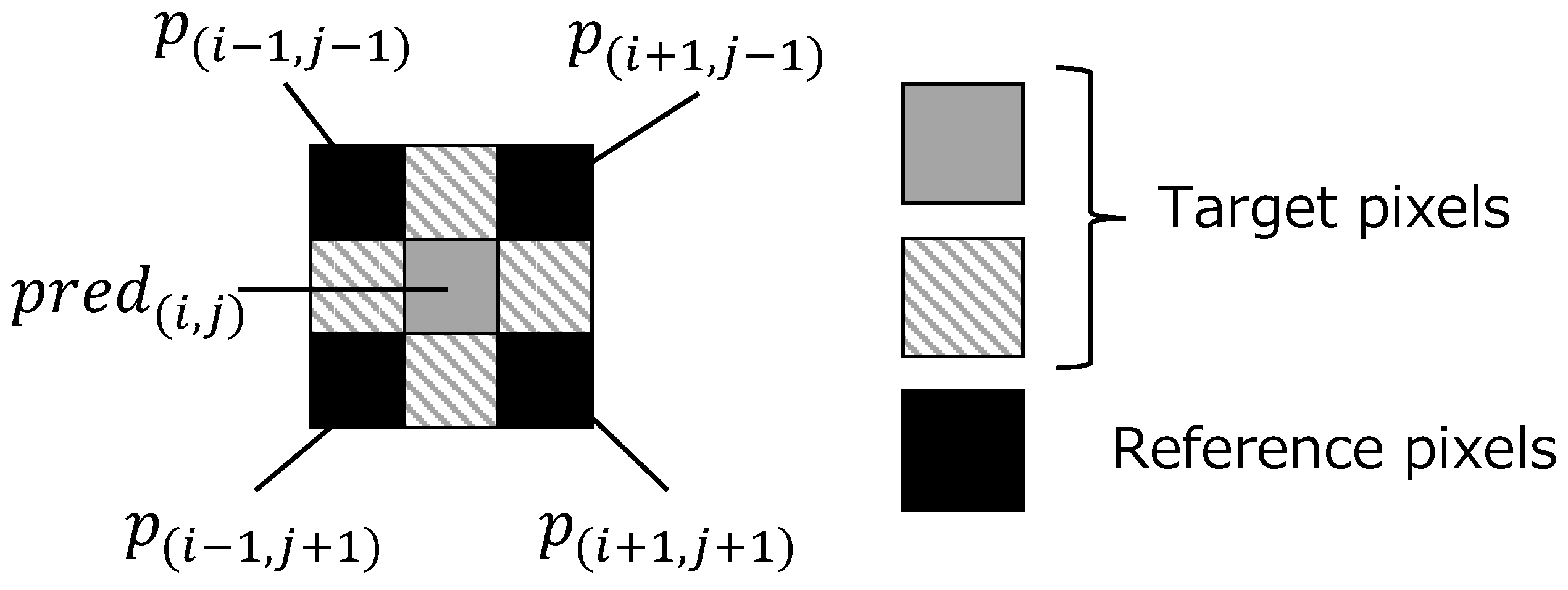


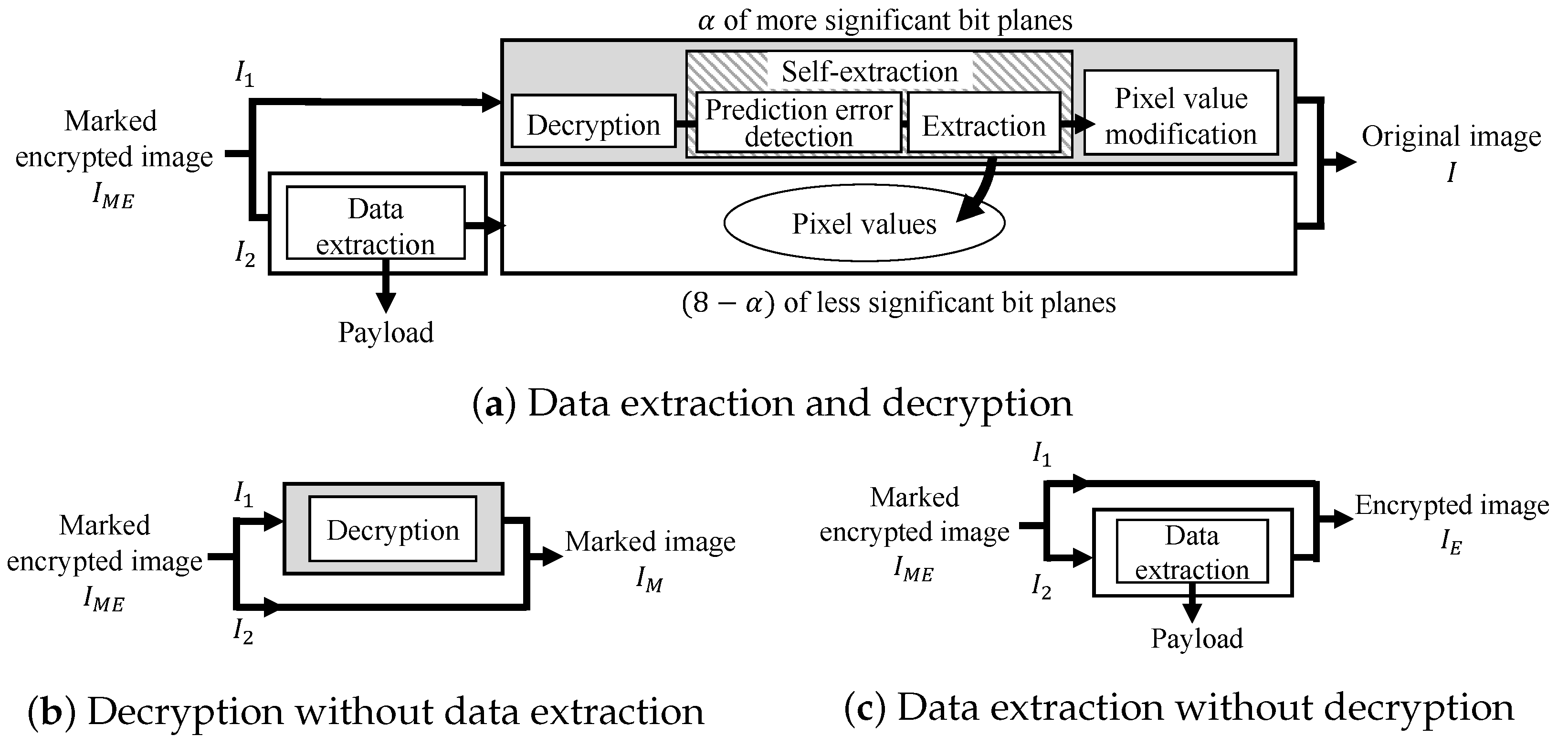

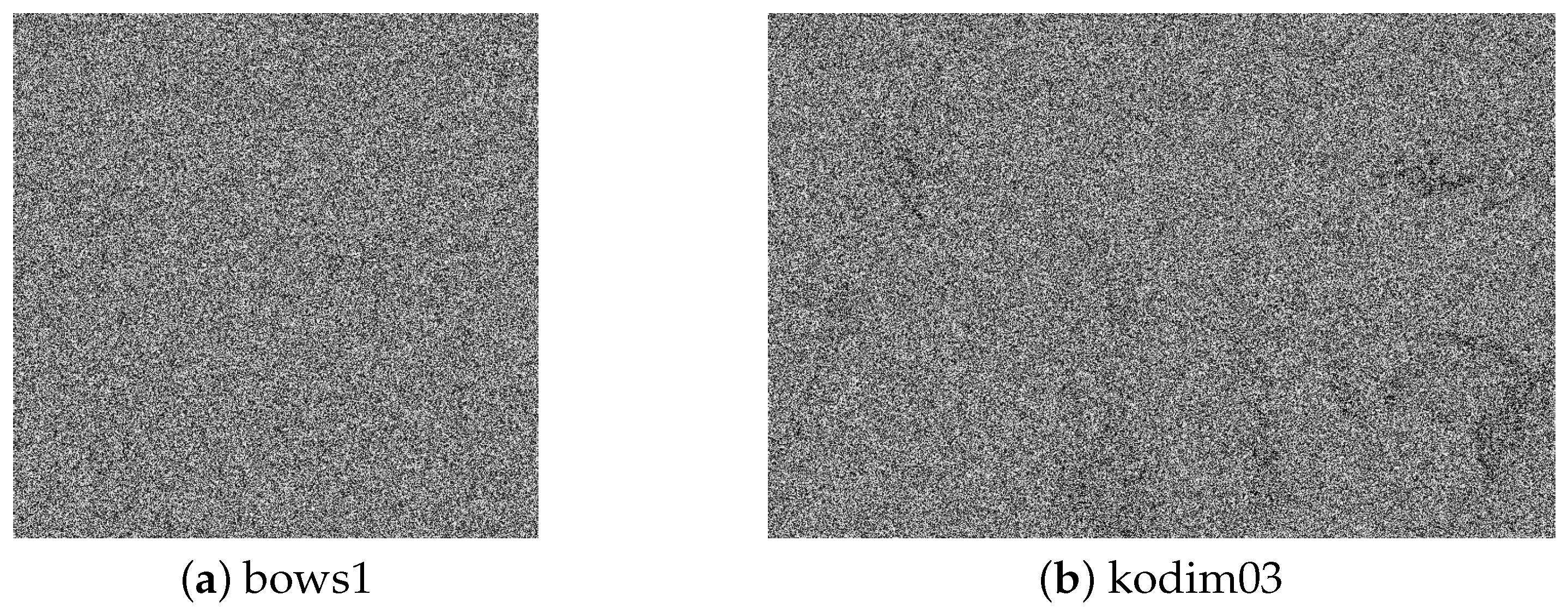
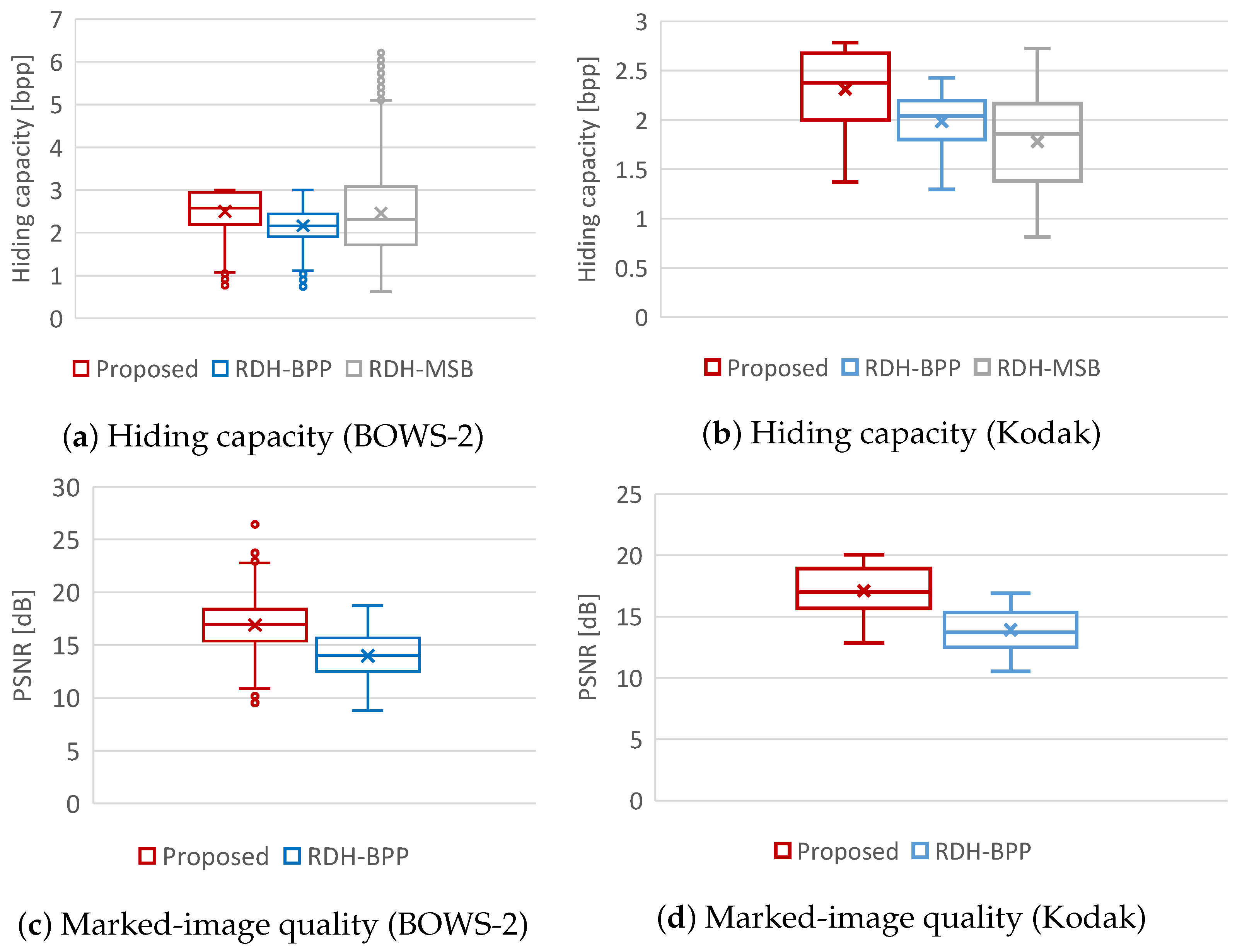
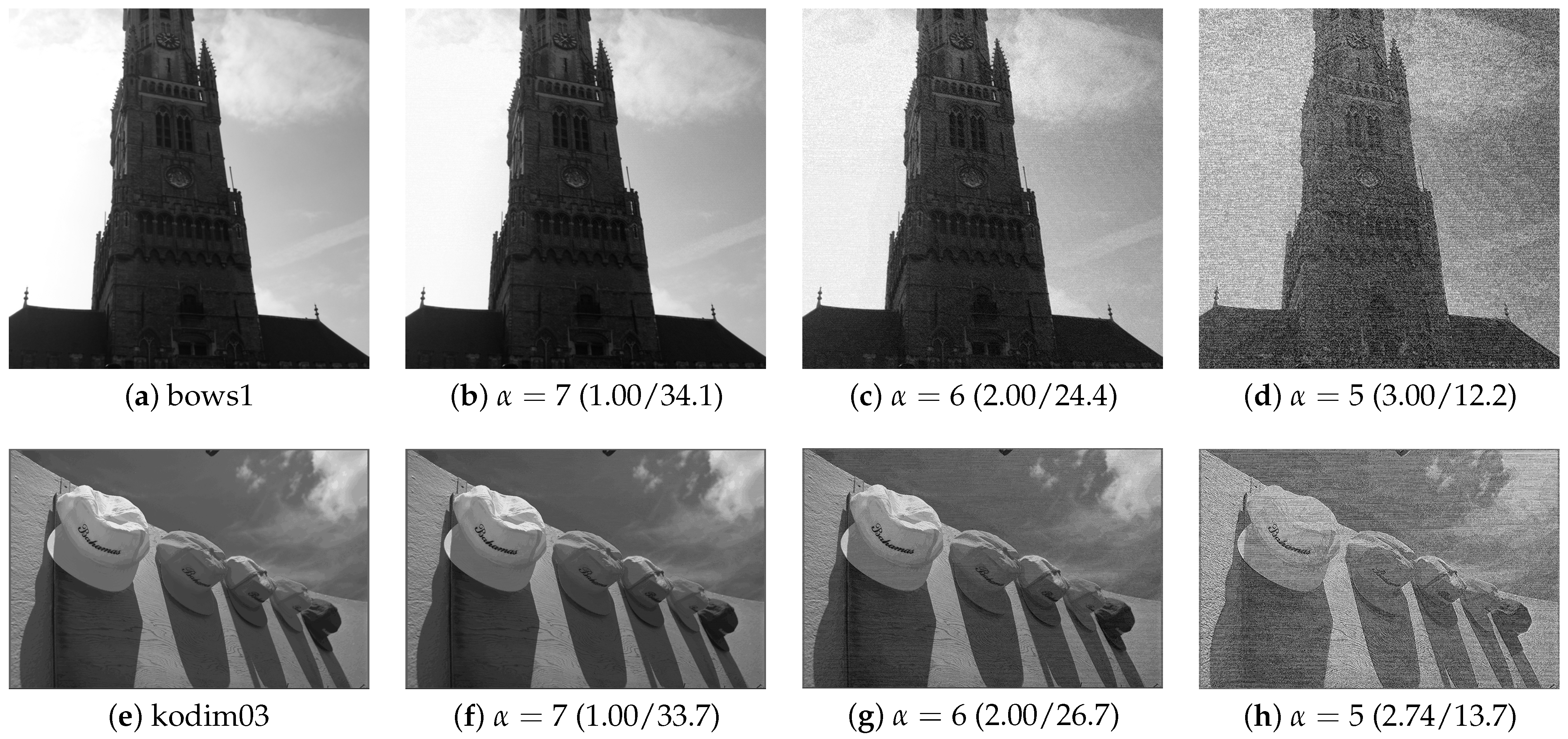

| Hiding Capacity [bpp] | ||
|---|---|---|
| BOWS-2 | Kodak | |
| Proposed | 2.50 | 2.31 |
| RDH-BPP [11] | 2.17 | 1.99 |
| RDH-MSB [14] | 2.46 | 1.78 |
| Dataset | PSNR [dB] | SSIM | RCE | |
|---|---|---|---|---|
| Proposed | BOWS-2 | 16.9 | 0.2060 | 0.5019 (+0.0019) |
| Kodak | 17.1 | 0.3275 | 0.5227 (+0.0227) | |
| RDH-BPP [11] | BOWS-2 | 14.0 | 0.1729 | 0.5110 (+0.0110) |
| Kodak | 13.9 | 0.2322 | 0.5438 (+0.0438) |
Publisher’s Note: MDPI stays neutral with regard to jurisdictional claims in published maps and institutional affiliations. |
© 2022 by the authors. Licensee MDPI, Basel, Switzerland. This article is an open access article distributed under the terms and conditions of the Creative Commons Attribution (CC BY) license (https://creativecommons.org/licenses/by/4.0/).
Share and Cite
Arai, E.; Imaizumi, S. High-Capacity Reversible Data Hiding in Encrypted Images with Flexible Restoration. J. Imaging 2022, 8, 176. https://doi.org/10.3390/jimaging8070176
Arai E, Imaizumi S. High-Capacity Reversible Data Hiding in Encrypted Images with Flexible Restoration. Journal of Imaging. 2022; 8(7):176. https://doi.org/10.3390/jimaging8070176
Chicago/Turabian StyleArai, Eichi, and Shoko Imaizumi. 2022. "High-Capacity Reversible Data Hiding in Encrypted Images with Flexible Restoration" Journal of Imaging 8, no. 7: 176. https://doi.org/10.3390/jimaging8070176
APA StyleArai, E., & Imaizumi, S. (2022). High-Capacity Reversible Data Hiding in Encrypted Images with Flexible Restoration. Journal of Imaging, 8(7), 176. https://doi.org/10.3390/jimaging8070176







